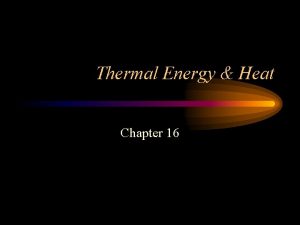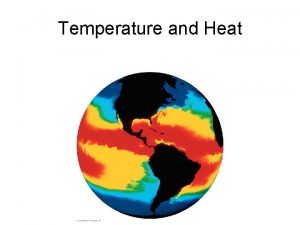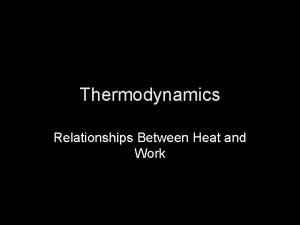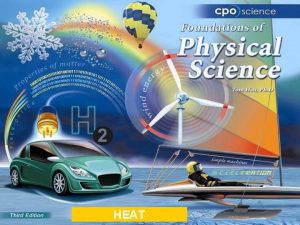Work and Heat Chapter 16 Heat is the











- Slides: 11

Work and Heat – Chapter 16 – Heat is the transfer of thermal energy from one object to another through a temperature difference. – HEAT FLOWS FROM HOT TO COLD!!!!

A. Temperature • Temperature – measure of the average KE of the particles in a sample of matter – (how fast are the atoms/molecules moving? )

Temperature – measure of how hot or cold something is in relation to amount of kinetic energy an object has – SI unit for temperature is Kelvins (K)

Thermal Energy • Which beaker of water has more thermal energy? – B - same temperature, more mass 80ºC A B 200 m. L 400 m. L

Heat Transfer • Heat – thermal energy that flows from a warmer material to a cooler material • Like work, heat is. . . – measured in joules (J) – a transfer of energy

Conduction – Transfer of thermal energy when 2 materials TOUCH • Thermal conductors: conduct thermal energy well • Thermal insulators: conduct thermal energy poorly

Convection – Transfer of thermal energy through particles flowing around an object • Heat is circulating (Ovens, ocean currents) • OBJECTS NOT TOUCHING FOR HEAT TRANSFER

Radiation • Heat transferred through space as a wave of energy. • Ex. Heat/light from the sun. • Ex. Heat/light from fire.

Laws of Thermodynamics – 1 st Law: Energy can not be created or destroyed, it can change onto other forms – 2 nd Law: Heat can flow from cold to hot ONLY if you add WORK • Example: Refrigerator

Specific Heat Capacity • Specific Heat = the ability of a substance to absorb heat energy. (The number of calories needed to raise the temperature of 1 gram of the substance by 1 C. ) ***Specific Heat Capacity (c) Values are Constant. (Water has a cp of 1 cal/g x C) Thermal change (J)= Mass (kg) x T ( C) x Specific Heat Capacity (cal/g x C) Q= m T c

Specific Heat Practice Problems • Find the change in thermal energy of a 20 -kg wooden chair that warms from 15 C to 30 C if the specific heat of wood is 700 J/(kg C). • The air in a living room has a mass of 72 kg and a specific heat of 1010 J/(kg C). What is the change in thermal energy of the air when it warms from 15 C to 30 C?
 Chapter 4 section 1 work and machines answer key
Chapter 4 section 1 work and machines answer key Hình ảnh bộ gõ cơ thể búng tay
Hình ảnh bộ gõ cơ thể búng tay Ng-html
Ng-html Bổ thể
Bổ thể Tỉ lệ cơ thể trẻ em
Tỉ lệ cơ thể trẻ em Gấu đi như thế nào
Gấu đi như thế nào Tư thế worms-breton
Tư thế worms-breton Chúa yêu trần thế alleluia
Chúa yêu trần thế alleluia Các môn thể thao bắt đầu bằng tiếng chạy
Các môn thể thao bắt đầu bằng tiếng chạy Thế nào là hệ số cao nhất
Thế nào là hệ số cao nhất Các châu lục và đại dương trên thế giới
Các châu lục và đại dương trên thế giới Cong thức tính động năng
Cong thức tính động năng





















